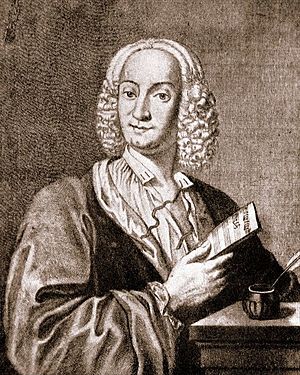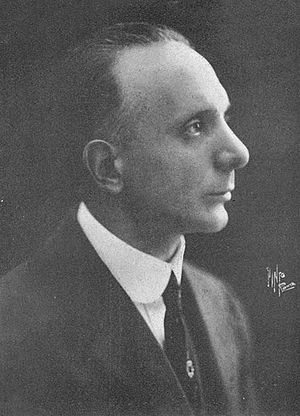The Four Seasons (Vivaldi) facts for kids
The Four Seasons (in Italian, Le quattro stagioni) is a famous group of four violin concertos by the Italian composer Antonio Vivaldi. Each concerto is like a musical story about one of the four seasons: Spring, Summer, Autumn, and Winter. Vivaldi wrote these around 1718–1720 when he worked in Mantua, Italy. They were published in 1725 in Amsterdam as part of a larger collection called Il cimento dell'armonia e dell'inventione, which means The Contest Between Harmony and Invention.
The Four Seasons is Vivaldi's most well-known work. It was a big step forward in how music could tell a story. Vivaldi used music to paint pictures of nature. You can hear flowing streams, birds singing, a shepherd with his barking dog, buzzing flies, and even storms. He also described drunken dancers, hunting parties, frozen landscapes, and warm winter fires.
Vivaldi did something unusual for his time: he published the concertos with poems, called sonnets. These poems helped explain what feelings and scenes Vivaldi wanted his music to create for each season. This makes The Four Seasons one of the earliest and best examples of what we call program music. Program music is instrumental music that tells a story or describes something outside of music itself. Vivaldi carefully matched his music to the words of the poems. For example, in the middle part of "Spring," when the shepherd sleeps, you can hear his dog barking in the viola section of the orchestra. Each concerto has three parts, called movements (fast–slow–fast), and each sonnet is also divided into three sections.
Contents
The Music's Structure
Vivaldi organized The Four Seasons like this:
- Concerto No. 1 in E major, Op. 8, RV 269, "Spring" (La primavera)
- Allegro (Fast)
- Largo e pianissimo sempre (Very slow and very soft)
- Allegro pastorale (Fast, like a shepherd's song)
- Concerto No. 2 in G minor, Op. 8, RV 315, "Summer" (L'estate)
- Concerto No. 3 in F major, Op. 8, RV 293, "Autumn" (L'autunno)
- Allegro (Fast)
- Adagio molto (Very slow)
- Allegro (Fast)
- Concerto No. 4 in F minor, Op. 8, RV 297, "Winter" (L'inverno)
- Allegro non molto (Fast, but not too much)
- Largo (Slow)
- Allegro (Fast)
Playing all four concertos usually takes about 40 to 43 minutes. Here are the approximate times for each one:
- Spring: 10 minutes
- Summer: 11 minutes
- Autumn: 11 minutes
- Winter: 9 minutes
Sonnets and Hidden Meanings
There's a discussion about whether Vivaldi wrote the music to fit the sonnets, or the sonnets to fit the music. We don't know for sure who wrote the poems. However, it's thought Vivaldi might have written them himself because each sonnet is divided into three parts, just like each concerto has three movements.
No matter who wrote them, The Four Seasons is a great example of program music. This means the instrumental music is meant to make you think of something outside of the music itself. Vivaldi wanted to show that this kind of music could be taken seriously.
Besides the sonnets, Vivaldi also added short notes in the music. These notes tell the musicians what sounds to create. For example, he wrote "The barking dog" for a part in "Spring," "Languor caused by the heat" for a part in "Summer," and "the drunkards have fallen asleep" for a part in "Autumn."
Sonnet Texts
Here are the English translations of the sonnets that go with each season's music:
| Sonnet | English Translation |
|---|---|
| Spring |
Allegro |
| Summer |
Allegro non molto |
| Autumn |
Allegro |
| Winter |
Allegro non molto |
Recording History
The very first recording of The Four Seasons is a bit unclear. There's a recording by violinist Alfredo Campoli from a French radio show, thought to be from early 1939. The first proper electrical recording was made in 1942 by Bernardino Molinari. His recording was released in Italy and later in the United States.
The first American recording was made in late 1947 by violinist Louis Kaufman. This recording helped make Vivaldi's music popular again in Europe and America. It won a French award, the Grand Prix du Disque, in 1950. It was also added to the Grammy Hall of Fame in 2002. Kaufman later recorded all twelve concertos from Vivaldi's Op. 8, making his the first complete recording of that collection.
The group I Musici recorded The Four Seasons many times, starting in 1955. Another very popular recording was made in 1969 by the Academy of St Martin in the Fields, led by Neville Marriner, with soloist Alan Loveday. This recording sold over half a million copies!
Nigel Kennedy's 1989 recording with the English Chamber Orchestra sold over two million copies, becoming one of the best-selling classical works ever. Many other musicians have recorded The Four Seasons, trying different ways to play it, sometimes using older instruments or adding their own musical touches. By 2011, there were about 1,000 recorded versions of this famous work.
Other Works Inspired by The Four Seasons
The Four Seasons has inspired many other artists and composers. People have made new arrangements, transcriptions, covers, remixes, and even parodies of the music. It has been used in theater, opera, films, video games, and ballets. Vivaldi himself seemed to start this trend of adapting his own music. Since then, his work has spread into many different types of performing arts around the world.
Here are some examples of how The Four Seasons has been used or changed:
- 1726: Vivaldi used parts of his "Spring" concerto in his opera Dorilla in Tempe.
- 1727: Vivaldi based an aria (a song) from his opera Farnace on the first movement of the "Winter" concerto.
- 1739: Nicolas Chédeville arranged the concertos for instruments like the hurdy-gurdy.
- 1765: French composer Michel Corrette created a choral piece using the music from the "Spring" concerto.
- 1970: Astor Piazzolla from Argentina published Estaciones Porteñas ("The Four Seasons of Buenos Aires"), which are often played alongside Vivaldi's work.
- 1972: Moe Koffman from Canada recorded a jazz album of the concertos.
- 1981: The music was used in the movie The Four Seasons.
- 1984: Thomas Wilbrandt created "The Electric V," which mixed Vivaldi's work with electronic music.
- 1989: Nigel Kennedy's recording became a huge bestseller.
- 1990: A MIDI version of "Spring" was included with Windows 3.0.
- 1997: The Baronics recorded surf guitar versions of parts of the concertos.
- 1998: Vanessa-Mae recorded a crossover version of the "Summer" concerto for electric violin.
- 2003: Hayley Westenra adapted the "Winter" concerto into a song called "River of Dreams."
- 2005: Dark Moor recorded an electric-guitar version of the "Winter" concerto, which was used in the video game Frets on Fire.
- 2007: Celtic Woman recorded the "Winter" Largo with Italian vocals.
- 2012: German composer Max Richter created a new version called Recomposed by Max Richter: Vivaldi – The Four Seasons, where he changed about 75% of the original music.
- 2014: The Piano Guys recorded a popular arrangement for piano and cello, mixing the "Winter" concerto with "Let it Go" from the movie Frozen.
- 2019: "For Seasons" was a new version of the concertos that used computer programs to show climate change from 1725 to 2019.
- 2021: "The [Uncertain] Four Seasons" was created using human composers and AI based on climate predictions for 2050. Each performance changes to match the climate predictions for where it's played.
- 2022: The TV show Wednesday (TV series) featured the main character playing "Winter" on the cello.
Images for kids
See also
 In Spanish: Las cuatro estaciones para niños
In Spanish: Las cuatro estaciones para niños




